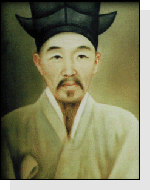- Park In- hwan (1926~1956)
- Park Su- geun (1914~1965)
- Kim Yu- jeong (1908~1937)
- Lee Hyo- seok (pen name Gasan) (1907~1942)
- Kim Dong- myeong (Choheo) (1901~1968)
- Han Yong- un (Buddhist name Manhae) (1897~1944)
- Namgung Eok (pen name Hanseo) (1863~1939)
- Yun Hui- sun (1860~1935)
- Yu In- seok (pen name Uiam) (1842~1915)
- Kim Byeong- yeon (pen name Nango) (1807~1863)
- Nam Gu- man (pen name Yakcheon) (1629~1711)
- Heo Mok (pen name Misu) (1595~1682)
- Heo Gyun (pen name Gyosan) (1569~1618)
- Heo Cho- hui (pen name Nanseolheon) (1563~1589)
- Sinsaimdang (1504~1551)
- Kim Si- seup (pen name Maewoldang) (1434~1493)
- Won Cheon- seok (pen name Ungok) (1330~ ?)
- Lee Seung- hyu (pen name Dongangeosa) (1224~1300)
Kim Byeong-yeon (pen name Nango) (1807~1863)

A vagabond poet, his pen name and alias were Nango and Kim Satgat, respectively. He hailed from Yangju, Gyeonggi Province.
His ancestor´s hometown was Andong. During Hong Gyeong-rae´s uprising in 1811 (11th year of King Sunjo),
his grandfather Kim Ik-sun, serving as Busa (governor) of Seoncheon, succumbed to Hong Gyeong-rae. Thus, as punishment,
his family and his descendants were not allowed to take offices in the government.
His mother avoided people scorning her family and moved to Yeongwol.
At 20, Kim Byeong-yeon passed a civil service examination organized by Dohobu (local governmental office) of Yeongwol. However, later when he heard from his mother about his family´s history, he realized that he had written a poem in the examination mocking his grandfather Kim Ik-sun in relation to the disgraceful defeat to Hong Gyeong-rae. He felt a sting of conscience about having abused his grandfather, and set on his vagabond life all over the country leaving behind his wife and children. He wore Satgat (a conical broad-rimmed hat) aimed at hiding his face as he felt ashamed and guilty of having abused his grandfather. He wandered and wrote many poems full of wit and humor as well as satire. In 1863 (14th year of King Cheoljong), he died in Hwasun, Jeolla Province and was temporarily buried there. However, his son moved his tomb to the current location at Norumok, Waseok-ri, Hadong-myeon, Yeongwol-gun. The traces of his house are left at Eodun, Waseok-ri.
At 20, Kim Byeong-yeon passed a civil service examination organized by Dohobu (local governmental office) of Yeongwol. However, later when he heard from his mother about his family´s history, he realized that he had written a poem in the examination mocking his grandfather Kim Ik-sun in relation to the disgraceful defeat to Hong Gyeong-rae. He felt a sting of conscience about having abused his grandfather, and set on his vagabond life all over the country leaving behind his wife and children. He wore Satgat (a conical broad-rimmed hat) aimed at hiding his face as he felt ashamed and guilty of having abused his grandfather. He wandered and wrote many poems full of wit and humor as well as satire. In 1863 (14th year of King Cheoljong), he died in Hwasun, Jeolla Province and was temporarily buried there. However, his son moved his tomb to the current location at Norumok, Waseok-ri, Hadong-myeon, Yeongwol-gun. The traces of his house are left at Eodun, Waseok-ri.
최근 업데이트 2023-01-10


